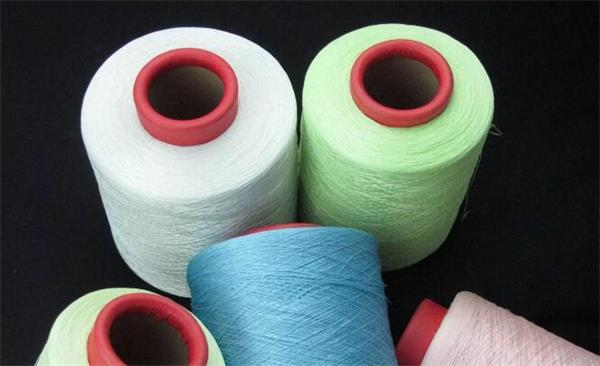
Polyester fibers after spinning and drawing have not yet perfected supermolecular structure and are not stable enough. Physical-mechanical properties are characterized by high strength, low elongation, and large initial modulus, but poor toughness and elasticity. When it is heated, it will produce a lot of shrinkage, which does not meet the requirements of the latter textile printing and dyeing process. For this purpose, it is necessary to heat-treat the polyester filament yarns in the post-processing process to repair and improve the fibers that have formed during the forming process. The structure improves the dimensional stability of the fiber and further improves the physical-mechanical properties of the fiber. In this paper, WAXD, density, speed of sound, birefringence and other analytical methods were applied to investigate the effect of heat setting process and changes of process parameters on the fiber structure of Yihua HV452 polyester staple fiber production line, and its mechanical properties were discussed.
Test Methods
Linear density, strength and elongation
In the standard state, the Viehromat M monofilament denier and the Fafe-graph M-type monofilament force meter of Textech-na previously West Germany were used to measure the clamping distance of 10 mm and the rate of decline was 20 mm/rain; the instrument automatically plotted the stress strain curve. .
Density
Determined at (25 ± 0.1) °C in a CCI/n-C2H10 system density gradient tube. The amorphous density ρ=1.335 g/cm3 and the crystal density ρ=1.455 g/cm3.
Birefringence
The German Leitz POL-BK polarized light microscope was measured by the optical path difference direct compensation method.
Sound speed
China Textile University SOM-l sound velocity meter, using the double-length method to determine the sound speed orientation factor, acoustic modulus.
Crystallinity and apparent grain size
The Rigaku D/max-RC type X-ray diffractometer was measured with a graphite crystal monochromator. Cu target, tube voltage 40kV, tube current 100mA, λ=1.542A, scan range 6°~36°, DS=SS=1°, RS=0.15mm, data processing using the CPR method, the following Calculate crystallinity:
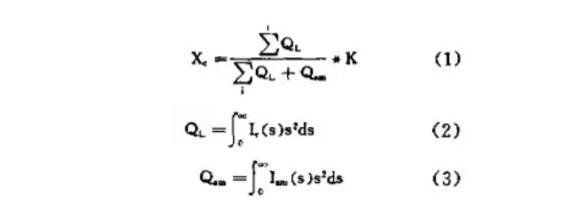
In the formula, I is the diffraction peak of the first "1" crystalline peak, I is the amorphous peak diffraction intensity, S = 2sinθ/λ, and K is the lattice distortion factor, taking K=1.
The apparent grain size is calculated according to the Scherrer equation:

In the formula, & is the corrected half-width, expressed in radians; λ=1.542A, and the K-value is 0.89.
Determination of crystal orientation factor f
RigakuD/max-RC type X-ray diffractometer and FS-3 fiber sample holder, positioning 2θ=42.9°, performing latitudinal scanning, with the formula:

Find the mean square cosine of the (105) crystal plane and use the formula:

Find the C-axis mean square cosine. According to Herman's formula:

Results and discussion
Structural changes of polyester in various areas of heat setting
When producing high-strength low-extension fibers, Yihua HV452 polyester staple fiber production line only undergoes intense heat setting and no relaxation heat setting. The heat setting mainly depends on the third drafting machine (DF-3) and the tension heat setting machine (HR ) and other two processes to carry out. For this purpose, we sampled at the different rollers in the DF-3 and HR under the experimental process parameters to examine the effect of heat setting.
Crystal structure
The crystal structure parameters of each stage of heat setting are listed in Table 2.
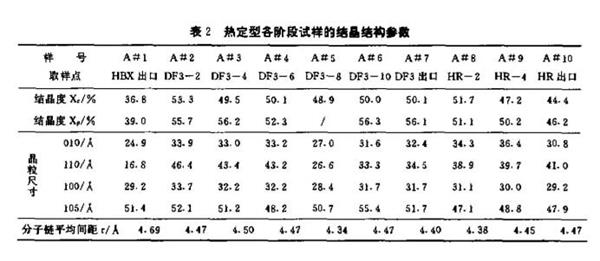
Generally, 1.5 MPa (15kgf/cm*G) steam is introduced into the twelve rollers of the third drafting machine. The surface temperature of the roller is generally about 190°C, and it mainly functions as drying, heating and partial tension heat setting. Using empirical formulae, it is necessary to enter the DF-3 filament yarn dryer to reach about 120°C, which requires about 0.987s, and from the drying temperature to the forming temperature of 190°C, it takes about 1.182s, and the uniaxial contact time is 0.25s. The first four rollers can be divided into the drying zone, the middle five rollers are the heating zone, and the latter three rollers are the setting zone [1].
From Table 2, it can be seen that at the second roll in the third drafting machine, the crystallinity has basically reached saturation, indicating that the thermal crystallization of the polyester fiber in the setting is completed in a very short time, and then passes through a The heat balance process of "crystallisation, melting, recrystallization" stabilizes the crystallization and refines the crystal grains, leading to "structural reforming".
That is to say, the heat setting has been started while the fiber tow is drying. The heating process of the fiber in the entire DF-3 is actually an intense heat setting process of the fiber tow under a certain tension, not just after The three-roller is the setting area because the factor that causes fiber crystallization in DF-3 is not only a temperature factor, but the strain-induced crystallization and thermal crystallization under a certain tension in the tension heat setting result in the strain-induced strain. The crystallization is actually a continuation of the tensile strain crystallized (orientation-induced crystallization) port produced in the secondary high-temperature stretching that occurs between the second drafting machine and the third drafting machine, because between the rollers of the stretching machine No large stretch deformation occurs, only the larger stress that occurs during stretching.
Then, due to the controlled shrinkage heat setting process adopted by HR, the speed of the tension heat setting machine was 3% slower than that of the third drafting machine, and the fiber tow was retracted by approximately 3% at 165 to 190°C. In this way, on the one hand, the tow of the tow under tension does not easily produce excessive de-orientation, on the other hand it controls a certain amount of contraction, so that part of the internal stress of the silk Cambodia is relaxed, and part of the high-elastic deformation is eliminated or transformed into a plastic deformation.
The crystallinity results also indicate that the crystallinity of HR is lower than that of DF-3. This is mainly due to the fact that during tension heat setting of DF-3, the tension will hinder the folding of PET macro chains in the vertical direction of the fiber axis. As the speed of HR decreases, the tension on the fiber tow is partially relieved and a partial retraction occurs, resulting in partial elimination of the internal stress of the fiber and leaving the macromolecule in a free state. This results in the orientation of the macromolecule during the intense heat setting. The band-like crystals formed between molecules are recovered by thermal relaxation and converted into folded crystals and ordered amorphous crystals.
Secondly, in the heat setting process, the degree of tension in the molecular chain of the amorphous region is not uniform, and the degree of relaxation recovery is not uniform, which may cause the crystal grains to generate rotational motion that deviates from the fiber axis direction. Third, the reduction of HR velocity and temperature leads to a decrease in the heat setting temperature of the fiber tow, which causes a non-thermal equilibrium under the control of thermodynamics under the influence of tension during the retraction of the fiber tow, except for new thermal crystallization. However, there is still "hot melting". Part of the imperfect crystals transform into ordered amorphous. Because of the above three effects, the crystallinity of HR is lower than that of DF-3.
Similarly, the lower crystallinity at the outlet of the HR is due to the fact that the speed of the oil-winding machine is 2% slower than that of the tension heat setting machine, so that the fiber tow is partially retracted and the internal stress is further eliminated. Finally, despite the lower crystallinity in heat setting after heat setting, due to a “tensile-thermal relaxation” process, the internal stress is eliminated and the thermodynamic equilibrium of “melting-crystal” is finally formed, so that the crystallization is stable. In terms of grain refinement overall, Tensile heat setting is a thermodynamically controlled equilibrium process in which the tensile stress gradually weakens. It is not only a function of stress temperature but also a function of time.
In addition, apparent grain size data indicates that during the heat setting process, the grain growth is not significant. In other words, in the previous pre-stretching, the molecular chains have been arranged neatly, the temperature rises, the points are adjusted to the sleeping position, and the cells are easily accessible, and the orientation in the other directions cannot enter the unit cell.
Orientation structure
Table 3 shows the orientation structure parameters of each stage of heat setting.
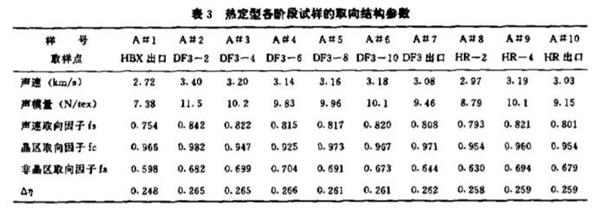
As can be seen from Table 3, the degree of fiber orientation at the second roll in the DF-3 slightly increased. This is mainly due to the presence of tension during the heat setting in the tension state, which leads to the orderly arrangement of the macromolecules inside the fiber along the fiber axis, which increases the degree of fiber orientation. The process of “melting a crystal and remelting and recrystallizing” is a thermodynamic equilibrium process, so the degree of orientation is basically unchanged.
When reaching the HR entrance, due to the decrease of the spinning speed, the fiber tow partially retracts, and the macromolecule inside the fiber transforms from the orientation state to the free state and then generates a certain folding recovery, so that the total orientation of the fiber sound velocity is measured. Amorphous orientation has been reduced, but with the above-mentioned occurrence of hot melting, partial crystals are transformed into ordered amorphous, and the formation of new crystals increases the overall orientation and amorphous orientation of the fiber sound velocity measurement. high.
The birefringence results indicate that the birefringence of the fibers has risen somewhat with the onset of intense heat setting, and has remained essentially unchanged after the eighth roll in DF-3 has decreased.
Physical properties
The physical properties of the samples at various stages of heat setting are shown in Table 4.
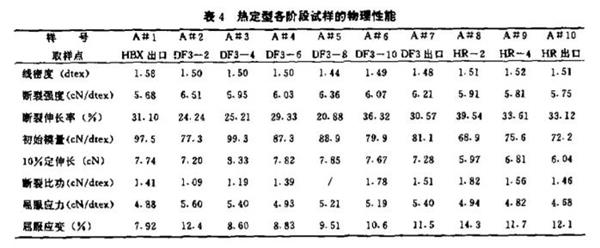
Effect of Steam Pressure Change on Fiber Structure Properties
Effect of DF-3 Steam Pressure Change on Fiber Structure Properties
The structural properties of polyester staple fiber with the DF-3 vapor pressure change are listed in Table 5.
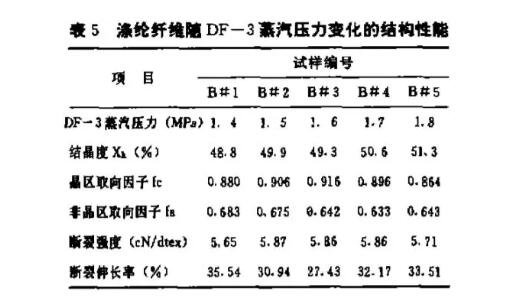
In actual production, the temperature of each heating roller is usually controlled by controlling the steam pressure of each heating roller. Therefore, it is of practical significance to examine the influence of the variation of the vapor pressure of each heating roller on the structural properties of the fiber. As can be seen from Table 5, the structural parameters and performance indexes of the polyester fiber are good between DF-3 steam pressures of 1.5-1.7 MPa. Although the crystallinity continues to increase after the steam pressure reaches 1.8 MPa, the crystal area and amorphous The regional orientation factor shows a downward trend.
The mechanical properties (tensile strength) of the fibers have also decreased. This shows that although the molecular thermal motion at a higher setting temperature can easily transform the ordered amorphous into crystals, it is also easy for the macromolecules to move freely and cause amorphous. The solution orientation of the zone, so that the orientation of the amorphous zone is reduced, and the fundamental structural factor that determines the mechanical properties of the fiber is the order of the amorphous regions of the fiber. Therefore, the thermal crystallization of the fiber in the post-processing process should be properly controlled. .
Effect of HR Steam Pressure Change on Fiber Structure Properties
Table 6 shows the structural performance data of polyester staple fibers with HR vapor pressure changes.
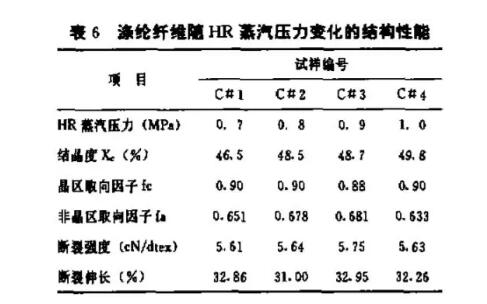
It can be seen from Table 6 that as the HR vapor pressure increases, the crystallinity and the orientation factor of the crystal area increase slightly, and the mechanical properties also increase. However, when the HR vapor pressure reaches 10 MPa, the crystallinity continues to increase. The orientation factor and mechanical properties of the amorphous region of the fiber have decreased, showing the same variation in the DF-3 vapor pressure. In the process of heat treatment, the heat setting conditions have a great influence on the orientation structure and physical properties of the finished fiber product. It is necessary to reasonably select the steam pressure of each heating roller of DF-3 and HR and control the heat setting temperature of each heating roller.
in conclusion
a. At the second roll in DF-3, crystallization is essentially complete due to the combined action of tensile strained crystallization and thermal crystallization. b. In the heat setting process, the structural reforming process is a thermodynamic equilibrium process in which the fiber tow gradually retracts and the tensile stress gradually weakens. c. The steam pressure of DF-3 and HR is not overheated, and the thermal crystallization of the fiber during post-processing should be properly controlled.










